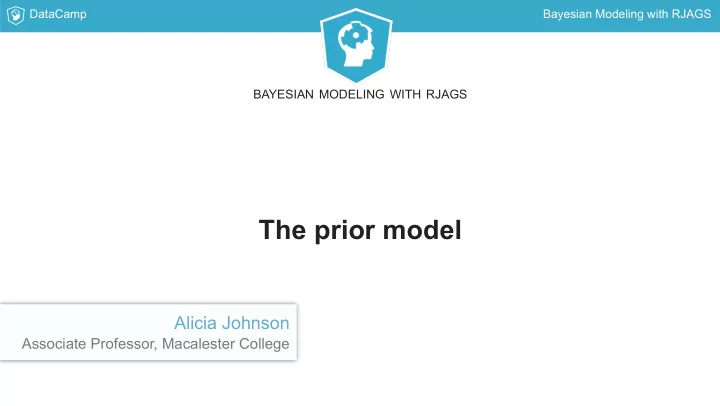

DataCamp Bayesian Modeling with RJAGS BAYESIAN MODELING WITH RJAGS The prior model Alicia Johnson Associate Professor, Macalester College
DataCamp Bayesian Modeling with RJAGS Course Goals Explore foundational, generalizable Bayesian models (eg: Beta-Binomial, Normal- Normal, and Bayesian regression) Define , compile , and simulate Bayesian models using RJAGS Conduct Bayesian posterior inference using RJAGS output
DataCamp Bayesian Modeling with RJAGS Bayesian elections: The prior
DataCamp Bayesian Modeling with RJAGS Bayesian elections: The prior
DataCamp Bayesian Modeling with RJAGS Bayesian elections: The prior
DataCamp Bayesian Modeling with RJAGS Bayesian elections: The data
DataCamp Bayesian Modeling with RJAGS Bayesian elections: The posterior
DataCamp Bayesian Modeling with RJAGS Bayesian elections: New data
DataCamp Bayesian Modeling with RJAGS Bayesian elections: New posterior
DataCamp Bayesian Modeling with RJAGS Bayesian elections: Newer data
DataCamp Bayesian Modeling with RJAGS Bayesian elections: Newer posterior
DataCamp Bayesian Modeling with RJAGS Bayesian thinking A Bayesian posterior model... combines insights from the prior model & observed data evolves as new data come in
DataCamp Bayesian Modeling with RJAGS Building a prior model p = proportion that support you p is between 0 and 1 The prior model for p is a Beta distribution with shape parameters 45 and 55 p ∼ Beta (45,55)
DataCamp Bayesian Modeling with RJAGS Tuning the prior
DataCamp Bayesian Modeling with RJAGS BAYESIAN MODELING WITH RJAGS Let's practice!
DataCamp Bayesian Modeling with RJAGS BAYESIAN MODELING WITH RJAGS Data & the likelihood Alicia Johnson Associate Professor, Macalester College
DataCamp Bayesian Modeling with RJAGS Polling Data parameter p = proportion that support you data X = 6 of n = 10 polled voters plan to vote for you insights You are more likely to have observed these data if p ≈ 0.6 than if p < 0.5 .
DataCamp Bayesian Modeling with RJAGS Modeling the dependence of X on p Poll assumptions: voters are independent p = probability that a voter supports you X = number of n polled voters that support you (count of successes in n independent trials, each having probability of success p ) Conditional distribution of X given p : X ∼ Bin ( n , p )
DataCamp Bayesian Modeling with RJAGS Dependence of X on p
DataCamp Bayesian Modeling with RJAGS Dependence of X on p
DataCamp Bayesian Modeling with RJAGS Dependence of X on p
DataCamp Bayesian Modeling with RJAGS Dependence of X on p
DataCamp Bayesian Modeling with RJAGS What's the likelihood?
DataCamp Bayesian Modeling with RJAGS Likelihood The likelihood function summarizes the likelihood of observing polling data X under different values of the underlying support parameter p . It is a function of p . high likelihood ⇒ p is compatible with the data low likelihood ⇒ p is not compatible with the data
DataCamp Bayesian Modeling with RJAGS BAYESIAN MODELING WITH RJAGS Let's practice!
DataCamp Bayesian Modeling with RJAGS BAYESIAN MODELING WITH RJAGS The posterior model Alicia Johnson Associate Professor, Macalester College
DataCamp Bayesian Modeling with RJAGS Bayesian election model prior: p ∼ Beta (45,55)
DataCamp Bayesian Modeling with RJAGS Bayesian election model prior: p ∼ Beta (45,55) likelihood: X ∼ Bin (10, p )
DataCamp Bayesian Modeling with RJAGS Bayesian election model prior: p ∼ Beta (45,55) likelihood: X ∼ Bin (10, p )
DataCamp Bayesian Modeling with RJAGS Posterior model of p prior: p ∼ Beta (45,55) likelihood: X ∼ Bin (10, p ) Bayes' Rule: posterior ∝ prior * likelihood
DataCamp Bayesian Modeling with RJAGS Getting Started with RJAGS RJAGS combines the power of R with the JAGS ( Just Another Gibbs Sampler ) engine. To get started: Download the JAGS program outside R Within R , install the rjags package
DataCamp Bayesian Modeling with RJAGS Bayesian Models in RJAGS: DEFINE # DEFINE the model X ∼ Bin ( n , p ) vote_model <- "model{ # Likelihood model for X p ∼ Beta ( a , b ) X ~ dbin(p, n) # Prior model for p Warning: p ~ dbeta(a, b) }" the rjags function dbin() is different than base dbinom()
DataCamp Bayesian Modeling with RJAGS Bayesian Models in RJAGS: COMPILE # DEFINE the model vote_model <- "model{ # Likelihood model for X X ~ dbin(p, n) # Prior model for p p ~ dbeta(a, b) }" # COMPILE the model vote_jags_A <- jags.model(textConnection(vote_model), data = list(a = 45, b = 55, X = 6, n = 10), inits = list(.RNG.name = "base::Wichmann-Hill", .RNG.seed = 100))
DataCamp Bayesian Modeling with RJAGS Bayesian Models in RJAGS: SIMULATE # DEFINE the model vote_model <- "model{ # Likelihood model for X X ~ dbin(p, n) # Prior model for p p ~ dbeta(a, b) }" # COMPILE the model vote_jags <- jags.model(textConnection(vote_model), data = list(a = 45, b = 55, X = 6, n = 10), inits = list(.RNG.name = "base::Wichmann-Hill", .RNG.seed = 100)) # SIMULATE the posterior vote_sim <- coda.samples(model = vote_jags, variable.names = c("p"), n.iter = 10000)
DataCamp Bayesian Modeling with RJAGS Bayesian Models in RJAGS: SIMULATE # PLOT the simulated posterior plot(vote_sim, trace = FALSE)
DataCamp Bayesian Modeling with RJAGS BAYESIAN MODELING WITH RJAGS Let's practice!
Recommend
More recommend